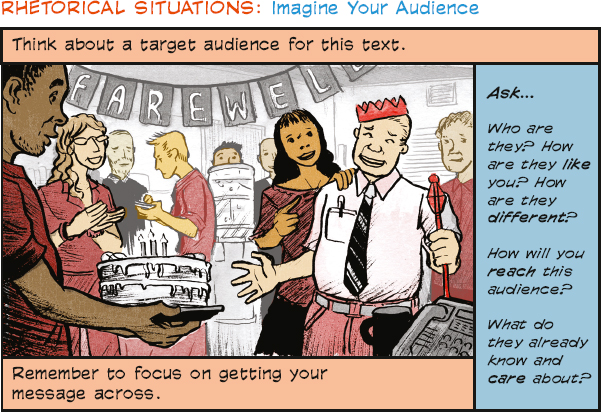5eAnalyze your audience.

Go to the Thinking Visually exercise to analyze this image
Every communicator can benefit from thinking carefully about who the audience is, what the audience already knows or thinks, and what the audience needs and expects to find out. One of the characteristics of an effective communicator is the ability to write for a variety of audiences, using language, style, and evidence appropriate to particular readers, listeners, or viewers. Even if your text can theoretically reach people all over the world, focus your analysis on those you most want or need to reach and those who are most likely to take an interest.
Informal and formal audiences
For some informal writing, you know exactly who your audience is, and communicating appropriately may be a simple matter. It’s still worth remembering that when you post in a public space, you may not be aware of how large and varied your online audience can be. Can your friend’s parents, or her prospective employer, see your posts on her Facebook page? (The answer depends partly on her privacy settings.) Who’s reading the blogs you comment on?
Even if you write with intuitive ease in tweets and texts to friends, you may struggle when asked to write for an instructor or for a “general audience.” You may wonder, for example, what a general audience might know about your topic, what they value, or what evidence they will find persuasive. When you are new to academic writing, making assumptions about such questions can be tricky. If you can identify samples of writing that appeal to a similar audience, look for clues about what that audience expects; if still in doubt, check with your instructor or drop by your campus writing center.
Bringing In Other Languages
FOR MULTILINGUAL WRITERS
Bringing In Other Languages
Even when you write in English, you may want or need to include words, phrases, or whole passages in another language. If so, consider whether your readers will understand that language and whether you need to provide a translation. See 22d for more on bringing in other languages.
Appropriate language for an audience
- Is the language of your text as clear as it needs to be for your audience? If your readers can’t understand what you mean, they’re not likely to accept your points.
- For academic writing, should you use any specialized varieties of English along with standard academic English? any occupational, professional, regional, or ethnic varieties? any words from a language other than English? any dialogue? (See Chapter 22.) How will these choices help you connect to your audience?
As you think about your audience, consider how you want them to respond to both the words and the images you use. And remember that images can evoke very strong responses in your audience and can affect the tone of your writing (5f), so choose them with special care.
Your Whole Audience
CONSIDERING DISABILITIES
Your Whole Audience
Remember that considering your whole audience means thinking about members with varying abilities and special needs. Approximately one in five Americans was living with a disability in the year 2000. All writers need to think carefully about how their words reach out and connect with such very diverse audiences.
Watch and respond to the video Developing a sense of audience.